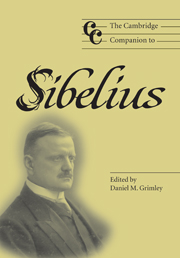Book contents
- Frontmatter
- Introduction
- Part I Forging a voice: perspectives on Sibelius's biography
- Part II Musical works
- 3 Pastoral idylls, erotic anxieties and heroic subjectivities in Sibelius's Lemminkäinen and the Maidens of the Island and first two symphonies
- 4 The later symphonies
- 5 The genesis of the Violin Concerto
- 6 Finlandia awakens
- 7 The tone poems: genre, landscape and structural perspective
- 8 Finnish modern: love, sex and style in Sibelius's songs
- 9 Sibelius and the miniature
- Part III Influence and reception
- Part IV Interpreting Sibelius
- Notes
- Select bibliography
- Index of names and works
4 - The later symphonies
from Part II - Musical works
Published online by Cambridge University Press: 28 September 2011
- Frontmatter
- Introduction
- Part I Forging a voice: perspectives on Sibelius's biography
- Part II Musical works
- 3 Pastoral idylls, erotic anxieties and heroic subjectivities in Sibelius's Lemminkäinen and the Maidens of the Island and first two symphonies
- 4 The later symphonies
- 5 The genesis of the Violin Concerto
- 6 Finlandia awakens
- 7 The tone poems: genre, landscape and structural perspective
- 8 Finnish modern: love, sex and style in Sibelius's songs
- 9 Sibelius and the miniature
- Part III Influence and reception
- Part IV Interpreting Sibelius
- Notes
- Select bibliography
- Index of names and works
Summary
Beginnings
One way of surveying the history of musical composition in the twentieth century is through consideration of the ways in which the time-honoured aesthetic aspiration to balance innovation and conservation, the individual voice and the common language, was carried forward. The idea that innovation and conservation are wholly opposed in the music of any era is simplistic fantasy, and the reality of an intricate interaction between divergent tendencies affecting form and style, technique and expression, has been increasingly acknowledged by commentators alert to the strategies by which composers – even when they disclaim all conscious intention – manage to exploit that interaction.
For some years after his death, Sibelius was generally regarded as more representative of the long nineteenth century, and of late Romanticism, than of the newly progressive twentieth century, with the implication that the reasons why he was so highly praised by influential critics like Donald Tovey and Constant Lambert were also the reasons why his influence on younger composers was harmful – inhibiting rather than liberating, dedicated to conservation and rejecting innovation. In this context, even Schoenberg's accolade that Sibelius – with Shostakovich – had ‘the breath of symphonists’ could be construed as a coded warning about the need for music to move beyond such tradition-enshrining categories: and awareness, after 1970, that tonality was showing a new capacity to adapt as well as to survive, increased the conviction that contemporary tonal music needed to avoid debilitating associations with late Romantic idioms and formal strategies.
- Type
- Chapter
- Information
- The Cambridge Companion to Sibelius , pp. 49 - 65Publisher: Cambridge University PressPrint publication year: 2004
- 1
- Cited by

